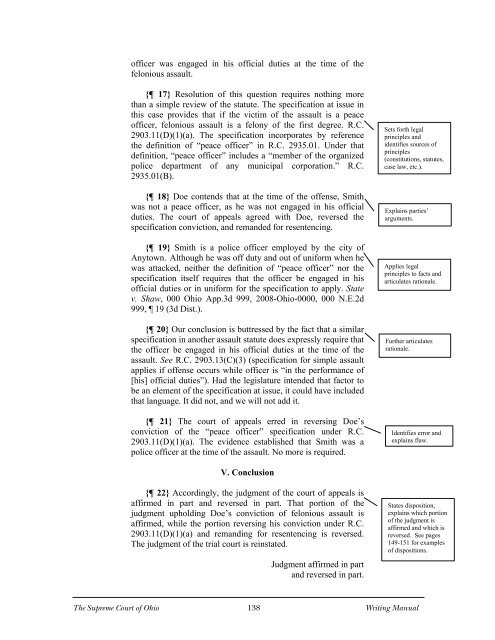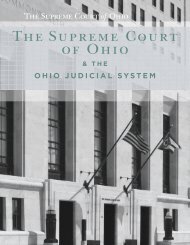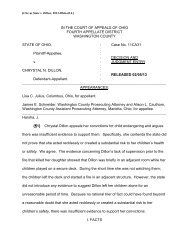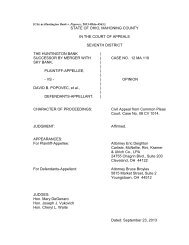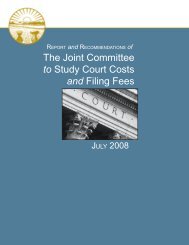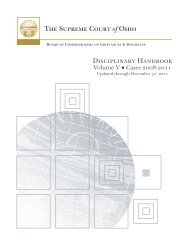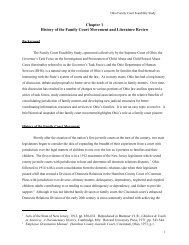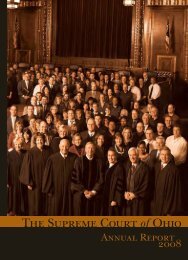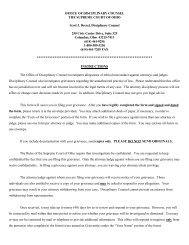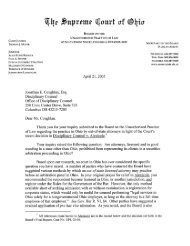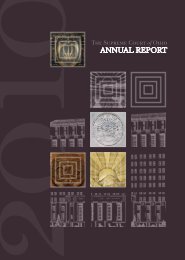WRITING MANUAL - Supreme Court - State of Ohio
WRITING MANUAL - Supreme Court - State of Ohio
WRITING MANUAL - Supreme Court - State of Ohio
You also want an ePaper? Increase the reach of your titles
YUMPU automatically turns print PDFs into web optimized ePapers that Google loves.
<strong>of</strong>ficer was engaged in his <strong>of</strong>ficial duties at the time <strong>of</strong> the<br />
felonious assault.<br />
{ 17} Resolution <strong>of</strong> this question requires nothing more<br />
than a simple review <strong>of</strong> the statute. The specification at issue in<br />
this case provides that if the victim <strong>of</strong> the assault is a peace<br />
<strong>of</strong>ficer, felonious assault is a felony <strong>of</strong> the first degree. R.C.<br />
2903.11(D)(1)(a). The specification incorporates by reference<br />
the definition <strong>of</strong> “peace <strong>of</strong>ficer” in R.C. 2935.01. Under that<br />
definition, “peace <strong>of</strong>ficer” includes a “member <strong>of</strong> the organized<br />
police department <strong>of</strong> any municipal corporation.” R.C.<br />
2935.01(B).<br />
{ 18} Doe contends that at the time <strong>of</strong> the <strong>of</strong>fense, Smith<br />
was not a peace <strong>of</strong>ficer, as he was not engaged in his <strong>of</strong>ficial<br />
duties. The court <strong>of</strong> appeals agreed with Doe, reversed the<br />
specification conviction, and remanded for resentencing.<br />
{ 19} Smith is a police <strong>of</strong>ficer employed by the city <strong>of</strong><br />
Anytown. Although he was <strong>of</strong>f duty and out <strong>of</strong> uniform when he<br />
was attacked, neither the definition <strong>of</strong> “peace <strong>of</strong>ficer” nor the<br />
specification itself requires that the <strong>of</strong>ficer be engaged in his<br />
<strong>of</strong>ficial duties or in uniform for the specification to apply. <strong>State</strong><br />
v. Shaw, 000 <strong>Ohio</strong> App.3d 999, 2008-<strong>Ohio</strong>-0000, 000 N.E.2d<br />
999, 19 (3d Dist.).<br />
{ 20} Our conclusion is buttressed by the fact that a similar<br />
specification in another assault statute does expressly require that<br />
the <strong>of</strong>ficer be engaged in his <strong>of</strong>ficial duties at the time <strong>of</strong> the<br />
assault. See R.C. 2903.13(C)(3) (specification for simple assault<br />
applies if <strong>of</strong>fense occurs while <strong>of</strong>ficer is “in the performance <strong>of</strong><br />
[his] <strong>of</strong>ficial duties”). Had the legislature intended that factor to<br />
be an element <strong>of</strong> the specification at issue, it could have included<br />
that language. It did not, and we will not add it.<br />
{ 21} The court <strong>of</strong> appeals erred in reversing Doe’s<br />
conviction <strong>of</strong> the “peace <strong>of</strong>ficer” specification under R.C.<br />
2903.11(D)(1)(a). The evidence established that Smith was a<br />
police <strong>of</strong>ficer at the time <strong>of</strong> the assault. No more is required.<br />
Sets forth legal<br />
principles and<br />
identifies sources <strong>of</strong><br />
principles<br />
(constitutions, statutes,<br />
case law, etc.).<br />
Explains parties’<br />
arguments.<br />
Applies legal<br />
principles to facts and<br />
articulates rationale.<br />
Further articulates<br />
rationale.<br />
Identifies error and<br />
explains flaw.<br />
V. Conclusion<br />
{ 22} Accordingly, the judgment <strong>of</strong> the court <strong>of</strong> appeals is<br />
affirmed in part and reversed in part. That portion <strong>of</strong> the<br />
judgment upholding Doe’s conviction <strong>of</strong> felonious assault is<br />
affirmed, while the portion reversing his conviction under R.C.<br />
2903.11(D)(1)(a) and remanding for resentencing is reversed.<br />
The judgment <strong>of</strong> the trial court is reinstated.<br />
Judgment affirmed in part<br />
and reversed in part.<br />
<strong>State</strong>s disposition,<br />
explains which portion<br />
<strong>of</strong> the judgment is<br />
affirmed and which is<br />
reversed. See pages<br />
149-151 for examples<br />
<strong>of</strong> dispositions.<br />
The <strong>Supreme</strong> <strong>Court</strong> <strong>of</strong> <strong>Ohio</strong> 138 Writing Manual


